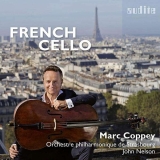Obwohl die Interpreten alle mit der Stadt Straßburg verbunden sind – Coppey wurde dort geboren, das Orchester hat dort seinen Sitz und Nelson ist mit dem Orchester durch seine Berlioz-Aufnahmen gut bekannt – geht es hier um Cellomusik, die der Stadt Paris zugerechnet wird. Zwei Konzerte, von Lalo und Saint-Saëns sowie die recht freien Symphonischen Variationen von Leon Boëllmann werden durch die Elegie von Fauré und den Schwan von Saint-Saëns ergänzt.
Mit immer schönem Ton, frei von technischen Geräuschen, und einem singenden Ansatz trägt Coppey seine Auswahl an Werken vor. Sicherlich liegt ihm die Musik seiner Heimat besonders am Herzen und auch in der Hand, so dass er mit Eleganz die Soli spielt. Hier ist ein Cellist am Werk, der sein Können zur kunstvollen Darstellung der Musik einsetzt und nicht mit reiner Oberflächlichkeit glänzen möchte. Beim Schwan aus dem Karneval der Tiere erzielt Coppey eine wunderbare Deutung, die den majestätisch gleitenden Vogel verbildlicht, ohne deswegen ins Kitschige abzugleiten. So setzt er zusammen mit dem Orchester einen sehr positiven Schlusspunkt.
Das Philharmonische Orchester Straßburg unter John Nelson zeigt seine Bereitschaft, sich im Interesse der Werke und des Solisten gehaltvoll in das Geschehen einzubringen. So erzielen sie eine plastische Begleitung, die den Stücken Gestalt gibt.
Es erscheint allerdings schon widersprüchlich, wenn im Beiheft u. a. Saint-Saëns die Ausformung eines französischen Stils in der Musik weit weg vom blendenden Virtuosentum und vom Klangrausch eines Richard Wagner zugewiesen wird, und dann die Aufnahme mit einem voluminösen und kraftvollen Klang aufwartet. So kann die Zierlichkeit des Mittelsatzes und die Einfachheit der Musik, so wie sie im Text vorgestellt wird, aufnahmetechnisch nicht transportiert werden, im Gegenteil. Das soll jetzt die Interpretation nicht abwerten, sondern auf die Diskrepanz hinweisen, wie sie öfters zwischen Booklet-Texten und Aufnahmen festzustellen ist.
Although the performers are all associated with the city of Strasbourg – Coppey was born there, the orchestra is based there, and Nelson is well acquainted with the orchestra through his Berlioz recordings – this is cello music attributed to the city of Paris. Two concertos by Lalo and Saint-Saëns and the rather free Symphonic Variations by Leon Boëllmann are complemented by Fauré’s Elegy and the Swan.
Coppey performs with a beautiful tone, free of technical noise, and with a great lyricism. Certainly the music of his homeland is especially close to his heart and hand, so he plays the solos with elegance. Here is a cellist at work who uses his skills to present the music artfully and does not want to shine with pure superficiality. In the Swan from the Carnival of the Animals, Coppey achieves a wonderful interpretation that depicts the majestically gliding bird without slipping into kitsch. Thus, together with the orchestra, he sets a very positive final point here.
The Strasbourg Philharmonic Orchestra, under the baton of John Nelson, shows its willingness to engage in the action with substance in the interest of the works and the soloist. In this way they achieve a vivid accompaniment.
Yet we also must say that it seems contradictory when in the booklet Saint-Saëns is presented as a composer of a French style which is far away from the dazzling virtuosity and the majestic sound of a Richard Wagner, and then the recording has a full volume and massive power. Thus, the daintiness of the middle movement and the simplicity of the music, as claimed in the text, cannot be conveyed recording-wise, on the contrary.
This is not meant to devalue the interpretation, but to point out the discrepancy that can often be found between booklet texts and recordings.






















